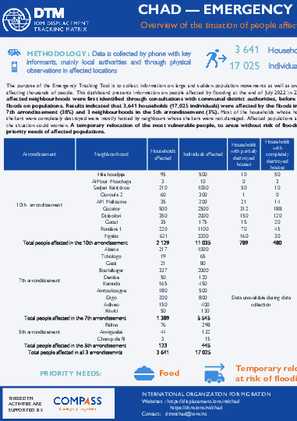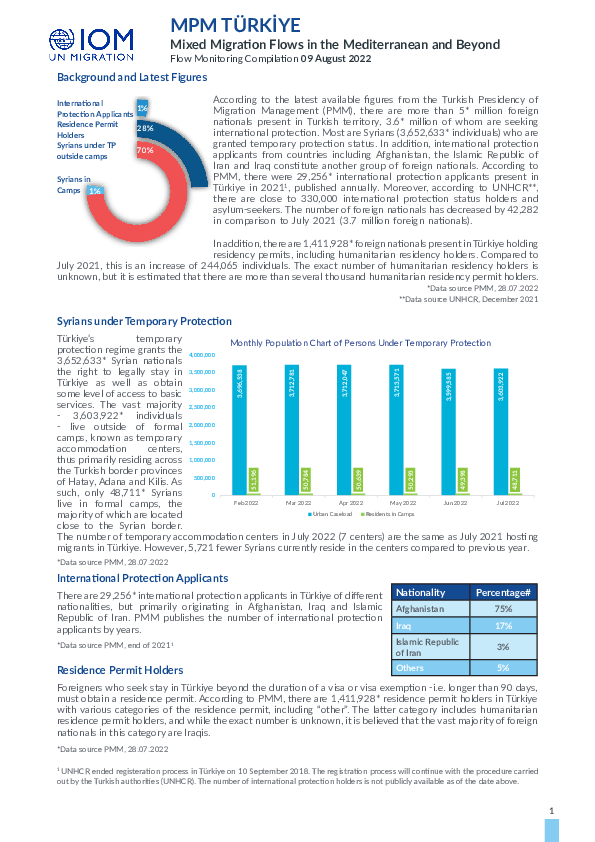-
Countries
-
Data and Analysis
-
Special Focus
-
Crisis Responses

Contact
DTM Chad, dtmtchad@iom.int
Language
English
Location
Chad
Period Covered
Aug 08 2022
Aug 10 2022
Activity
- Mobility Tracking
- Event Tracking
The purpose of the Emergency Tracking Tool is to collect information on large and sudden population movements as well as on security and climate emergencies. Each year in Chad, during the rainy season (June-September), many localities are often hit by floods, affecting thousands of people. This dashboard presents information on people affected by flooding at the end of July 2022 in 23 neighborhoods in the city of N'Djamena, following heavy rains. The data collection was carried out at two levels: the most
affected neighbourhoods were first identified through consultations with communal district authorities, before surveys were conducted with delegates of the identified neighbourhoods to collect information on the impact of the floods on populations. Results indicated that 3,641 households (17,025 individuals) were affected by the floods.

Contact
DTMUkraine@iom.int
Language
Ukrainian
Location
Ukraine
Period Covered
Jul 25 2022
Aug 05 2022
Activity
- Baseline Assessment
Починаючи з 24 лютого 2022 року війна в Україні спричинила безпрецедентну гуманітарну кризу в усіх адміністративних підрозділах (областях) країни.
З 24-го липня по 5 сепрня Міжнародна організація з міграції (МОМ) провела базову оцінку території 914 громад, які приймають зареєстрованих внутрішньо переміщених осіб у 19 областях та в місті Києві, щоб отримати загальне уявлення про внутрішнє переміщення.
Проведення цієї оцінки підтримує цільове призначення та надання гуманітарної допомоги постраждалим населенням і служить попереднім джерелом для виявлення громад з високим рівнем переміщення.

Contact
DTMUkraine@iom.int
Language
English
Location
Ukraine
Period Covered
Jul 25 2022
Aug 05 2022
Activity
- Baseline Assessment
Starting on 24 February 2022, the war in Ukraine triggered an unprecedented humanitarian crisis across the country. Between 25 July and 5 August the International Organization for Migration (IOM) conducted an area baseline assessment of 914 hromadas* hosting IDPs in Kyivska, Dnipropetrovska, Poltavska, Vinnytska, Zakarpatska, Cherkaska, Lvivska, Khmelnytska, Ivano-Frankivska, Ternopilska, Odeska, Kirovohradska, Chernivetska, Zhytomyrska, Zaporizka, Chernihivska, Volynska, Rivnenska, Sumska oblasts and Kyiv city in order to gather initial trends on the number and geographic location of officially recorded internally displaced persons.
This routine assessment supports the targeting and provision of humanitarian assistance to the affected populations and serves as a preliminary source to identify oblasts and hromadas hosting high numbers of IDPs.
In Round 9 of DTM’s Area Baseline, IOM compiled information on more than 2,500,000 IDPs in 19 oblasts and Kyiv city.

Contact
DTM Türkiye, dtmturkey@iom.int
Language
English
Location
Republic of Türkiye
Period Covered
Jul 01 2022
Jul 31 2022
Activity
- Flow Monitoring
According to the latest available figures from the Turkish Presidency of Migration Management (PMM), there are more than 5* million foreign nationals present in Turkish territory, 3.6* million of whom are seeking international protection. Most are Syrians (3,652,633* individuals) who are granted temporary protection status. In addition, international protection applicants from countries including Afghanistan, the Islamic Republic of Iran and Iraq constitute another group of foreign nationals. According to PMM, there were 29,256* international protection applicants present in Türkiye in 20211, published annually. Moreover, according to UNHCR**, there are close to 330,000 international protection status holders and asylum-seekers. The number of foreign nationals has decreased by 42,282 in comparison to July 2021 (3.7 million foreign nationals).
In addition, there are 1,411,928* foreign nationals present in Türkiye holding residency permits, including humanitarian residency holders. Compared to July 2021, this is an increase of 244,065 individuals. The exact number of humanitarian residency holders is unknown, but it is estimated that there are more than several thousand humanitarian residency permit holders.
*Data source PMM, 28.07.2022
**Data source UNHCR, December 2021

Contact
DTM Turkey, dtmturkey@iom.int
Language
English
Location
Republic of Türkiye
Period Covered
Jul 01 2022
Jul 31 2022
Activity
- Flow Monitoring
- Migrants presence
- Mobility Tracking
According to the latest available figures from the Turkish Presidency of Migration Management (PMM), there are more than 5* million foreign nationals present in Turkish territory, 3.6* million of whom are seeking international protection. Most of those seeking international protection are Syrians (3,652,633* individuals) who are granted the temporary protection status in Türkiye. In addition, international protection applicants are most frequently nationals of Afghanistan, the Islamic Republic of Iran and Iraq constitute another group of foreign nationals. According to PMM, there were 29,256* international protection applicants present in Türkiye in 20211, published annually. Moreover, according to UNHCR**, there are close to 330,000 international protection status holders and asylum-seekers.
In addition, there are 1,411,928* foreign nationals under residence permit holder status; this number includes humanitarian residence holders.
*Data Source PMM, 28.07.2022
**Data source UNHCR, December 2021

Contact
DTM Europe, DTMMediterranean@iom.int
Language
English
Location
Republic of Moldova
Period Covered
Feb 24 2022
Aug 01 2022
Activity
- Flow Monitoring
- Migrants presence
Between 24 February and 1 August 2022, Ukrainian refugees represent 92 per cent (508,353) of all individuals registered at entry from Ukraine (UKR) to the Republic of Moldova (MDA). The remaining eight per cent (47,062) are other TCNs. Similarly, Ukrainian refugees represent 90 per cent (290,403) of all individuals registered while leaving the Republic of Moldova towards Romania during the reporting period and the remaining 10 per cent (32,829) are TCNs.
This report focuses on trends of TCNs from Ukraine to the Republic of Moldova, analyzing data about their stay or their subsequent movement out of the country.

Contact
DTM Nigeria, AllUsersInDTMNigeria@iom.int
Language
English
Location
Nigeria
Period Covered
Aug 01 2022
Aug 07 2022
Activity
- Mobility Tracking
- Event Tracking
Nigeria's north-central and north-west zones are afflicted with a multi-dimensional crisis rooted in long-standing tensions between ethnic and religious groups and involves attacks by criminal groups and banditry/hirabah (such as kidnapping and grand larceny along major highways). During the past years, the crisis has accelerated because of the intensification of attacks and has resulted in widespread displacement across the region.
Between 01 and 07 August, armed attacks by bandits in Kankara LGA of Katsina State and Kajuru LGA of Kaduna State, have led to new situation of forced displacement. During the period assessed, the DTM identified an estimated 1,631 individuals who were affected by attacks.

Contact
DTMAfghanistan@iom.int
Language
English
Location
Afghanistan
Period Covered
Mar 01 2022
Apr 30 2022
Activity
- Mobility Tracking
- Site Assessment
DTM has been conducting the Baseline Mobility Assessment in Afghanistan since 2016 to track mobility, provide information on population estimates, locations and geographic distribution of displaced and returnee populations, reasons for displacement, places of origin and periods of displacement. Vulnerabilities and multisectoral needs are covered in the Emergency Community- Based Needs Assessment (eCBNA) at the end of the report. Data is collected at the settlement level, through focus group discussions with community focal points and direct observations.
In Round 15, the DTM team witnessed a net increase in the number of all four target populations compared to the previous round (Round 14, collected in November and December 2021).

Contact
iomnepal@iom.int
Language
English
Location
Nepal
Period Covered
Jul 22 2022
Jul 05 2022
Activity
- Survey
- Flow Monitoring Survey
IOM Nepal collected data at 12 ground crossing points (GCPs) six formal and six informal, in an effort to better understand the migration movements between India and Nepal. The exercise intended to collate feedback from the migrants for improving COVID-19 related response and deliver multisectoral services, ultimately contributing to strengthen the GCPs’ capacities, providing safe and regular crossing for migrants. This exercise was conducted as a part of European Union Directorate General for European Civil Protection and Humanitarian Aid Operations funded “Effective Case Management by Strengthening Isolation Centres and Ground Crossing Points (GCPs) Management for Rapid Response and Preparedness Against COVID-19” project.
In total, 1,073 individuals (780 at formal GCPs and 293 at informal GCPs) were interviewed for the flow monitoring exercise in Province 1, Madhesh, Lumbini and Sudurpaschim Provinces. The report presents data collected on flows, demographics profile of migrants, services available to the migrants at the formal GCPs and suggestions for improvement of services. The survey at the informal GCPs was conducted to primarily assess the intensions of migrants for using informal GCPs. Since multisectoral services are only available at the formal GCPs, the survey does not include questions on services at informal GCPs.
Contact
DTMMali@iom.int
Location
Mali
Activity
- Mobility Tracking
- Baseline Assessment
Period Covered
Apr 01 2022 -Apr 30 2022
A baseline assessment is a sub-component of mobility tracking. It aims to collect data on IDP, migrant or returnee population presence in a defined administrative area of the country.
Population Groups
Survey Methodology
Unit of Analysis Or Observation
Type of Survey or Assessment
Keywords
Geographical Scope
Administrative boundaries with available data
The current dataset covers the following administrative boundaries